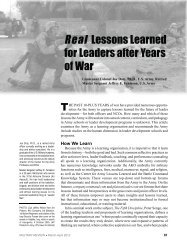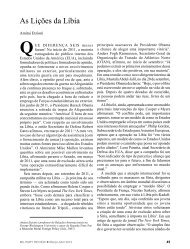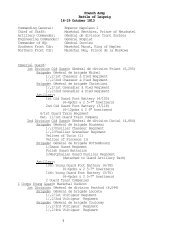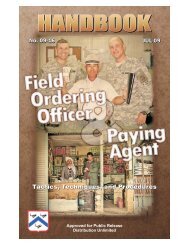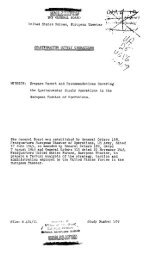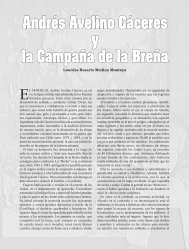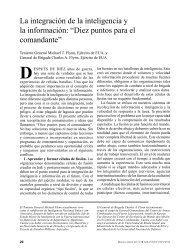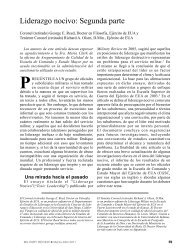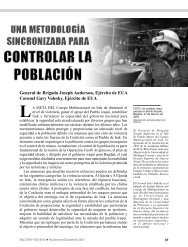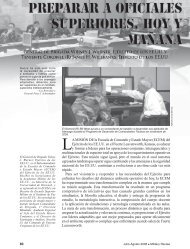ETO, Logistical Build-Up in the British Isles
ETO, Logistical Build-Up in the British Isles
ETO, Logistical Build-Up in the British Isles
You also want an ePaper? Increase the reach of your titles
YUMPU automatically turns print PDFs into web optimized ePapers that Google loves.
SEGTIOW 19<br />
SOBTIXG SHEDS<br />
70. Sasis of Rcsuircncnt. As soon as substmtid quantities of<br />
Uritcd Statcs S<strong>Up</strong>Dlica began wriv<strong>in</strong>g <strong>in</strong> <strong>the</strong> Britisb Islea, <strong>the</strong> ~ lan<br />
for gctt<strong>in</strong>g this ratcriel fron ship-aid0 to <strong>the</strong> proper depots was found<br />
to be un.rorkabla.<br />
me orig<strong>in</strong>al plan had bccn for SOS Supply 5orvicss to designate<br />
<strong>the</strong> deet<strong>in</strong>ntions of e.11 aupclies on each ship prior to <strong>the</strong> arrival of<br />
<strong>the</strong> dip.' The baais of this action was to be RZvance copies of <strong>the</strong> shipla<br />
wonifeat, prcceded by lod<strong>in</strong>g cableo. However, lhipsl manifests and o<strong>the</strong>r<br />
advicce vcrc found to be not <strong>in</strong> sufficient dotail to permit <strong>the</strong> pre-<br />
dceignation of cargo to tho cxtont nccessary to make <strong>the</strong> plan workable.<br />
A contributiig factor <strong>in</strong> thc failure of <strong>the</strong> plan was <strong>the</strong> <strong>in</strong>ability,<br />
espcciallp <strong>in</strong> 19k2 tud early 1943, of <strong>British</strong> dock workera, unfamiliar<br />
with United Statza aupnlica and mark<strong>in</strong>gs, to follow aamrrately<br />
such detailed shipp<strong>in</strong>g <strong>in</strong>stivctions BB could be given.<br />
Ano<strong>the</strong>r factor contribut<strong>in</strong>g to <strong>the</strong> coofusion was tho relatively<br />
largo percentago a i contc<strong>in</strong>ers that were <strong>in</strong>adequately markod os to contents,<br />
or were not marlecd e.$ all. An <strong>in</strong>dication of tne extant of this<br />
fail<strong>in</strong>g is <strong>the</strong> fact that <strong>in</strong> 1942 <strong>the</strong> New York Port viaa receiv<strong>in</strong>g for<br />
ahiprant approximatdy 24,000 pieces of unmarlced cargo daily.<br />
Thc remilt vas:<strong>the</strong> shipp<strong>in</strong>g of unaortcd mp9lics fron dooks to<br />
such depots ea at thc t<strong>in</strong>c had capacity to reccive <strong>the</strong>m. Those depots,<br />
after eort<strong>in</strong>e thc mp2lics And plac<strong>in</strong>g <strong>the</strong>m <strong>in</strong> <strong>the</strong>ir <strong>in</strong>ventoqj, were<br />
frequently directed to ship large quantities of <strong>the</strong>m to o<strong>the</strong>r depots<br />
to.BeLa~~ stock6 or to mcet immediate requirements. Phis <strong>in</strong>tsr-dapot<br />
shipment of wpliae gray to bo a scrioua burden on <strong>the</strong> dapot and tramportation<br />
systama which werc already work<strong>in</strong>g to capacity.<br />
Thcre werc threc possible solutions to this problem, a31 of<br />
whhiah wcrc cxploitcd: first, better documcntotlon by <strong>the</strong> Zone of <strong>the</strong><br />
Interior; second, iacrsas<strong>in</strong>g <strong>the</strong> Gfficibnoy of cargo identification by<br />
dock workers; thtrd, thc use of sort<strong>in</strong>g ahode with<strong>in</strong> <strong>the</strong> port area.<br />
(mc uno of sort<strong>in</strong>g sheds had not provioualy been coaptmplrrtad).<br />
71: Function of Sort<strong>in</strong>n Sheds. Tliia vas described by SOS a@<br />
roll.ow: IISort<strong>in</strong>g ahcde at or ncar ports &e used to clessi?., identify<br />
and Bort iiicom<strong>in</strong>g supplies, particularly sizad ltcms of Clotk<strong>in</strong>g and<br />
peckqcs which cannot -09 clcnrly idontificd from <strong>the</strong> manifsate. The<br />
purpoec is to assurc groper dfatribution of supplica to <strong>in</strong>land dopots,<br />
end to cl<strong>in</strong><strong>in</strong>atc trannhipneit between depots, thcmby rodw<strong>in</strong>& thc nubcr<br />
of rail wagons <strong>in</strong> uec.111<br />
As <strong>in</strong>dicctcd by thc c,borc 8te.tcmcr.t; sort<strong>in</strong>g shods wcrc used<br />
Ol!lY for such itcas as could not bc idcntiflcd and scgrogatod at Bhipaidc.<br />
Never morn than 3$ of U.S. tonnago hpndlod monthly by <strong>British</strong><br />
railweye m a fron sort<strong>in</strong>g sheds2.<br />
The rout<strong>in</strong>g of aupplics through sortiw shcds <strong>in</strong>volvcd a camplctc<br />
edditiocd handl<strong>in</strong>g an oaupmed with supplice that could be dire+<br />
1. SWr2rr:r cntitlcd t'dpprooiation of Installetions PrOgra", fWe 1943,<br />
by Chicf of Servicc, SOS. Smary publiahcd <strong>in</strong> 50s ET0 lf0verall<br />
Plan", dated x) June 1943.<br />
2. krious (monthly) Progcese Reports md Statistical SU"ariC8 published<br />
by SOS, <strong>ETO</strong>.<br />
- 36 -



